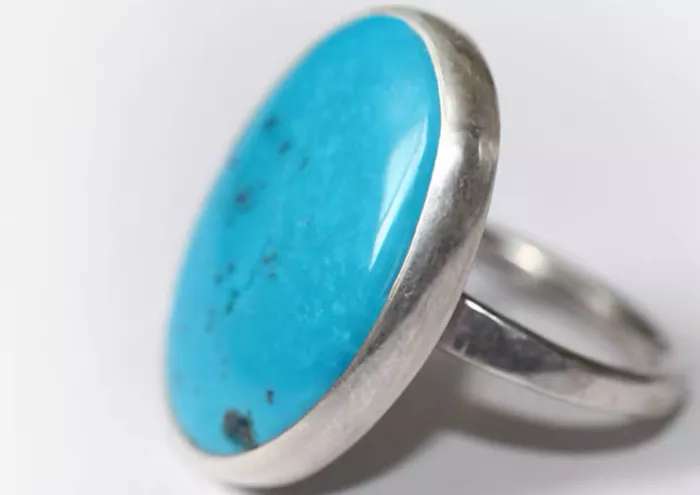Turquoise rings are beautiful and meaningful pieces of jewelry. Many people love them for their vibrant blue-green color and cultural significance. But how much does a turquoise ring cost? The price can vary widely depending on several factors.
In this guide, we will explore everything that affects the price of a turquoise ring. We will discuss the quality of the stone, the type of metal, the craftsmanship, and other important details. By the end, you will know what to expect when shopping for a turquoise ring.
What Influences the Price of a Turquoise Ring?
Turquoise rings can range from $20 to thousands of dollars. Why such a big difference? Several key factors determine the cost:
1. The Quality of the Turquoise Stone
Not all turquoise is the same. Some stones are more valuable than others. Here’s what affects the price:
Color:
The most prized turquoise has a bright, even blue color. Greenish or unevenly colored stones are usually less expensive.
Origin:
Some turquoise comes from famous mines, like Sleeping Beauty (Arizona) or Persian (Iran). These can be more expensive.
Matrix (Veining):
Some turquoise has dark veins running through it. Some people love this natural look, while others prefer clean, vein-free stones.
Treatments:
Natural, untreated turquoise is rare and costly. Many cheaper stones are stabilized (hardened with resin) or dyed to improve color.
2. The Type of Metal Used
The metal setting plays a big role in the price. Common options include:
Sterling Silver:
Affordable and classic, silver turquoise rings usually cost between 50and300.
Gold (10K, 14K, 18K):
Gold is more expensive. A gold turquoise ring can range from 200toover2,000.
Platinum:
Rare for turquoise rings, but if used, the price will be very high.
3. The Ring’s Design and Craftsmanship
Handmade rings cost more than mass-produced ones. Here’s why:
Handmade vs. Factory-Made:
Artisan-made rings have unique details and better quality. These can cost 200to1,500 or more.
Vintage or Antique Rings:
Older turquoise rings, especially from famous makers, can be very valuable. Prices depend on age and condition.
Custom Designs:
If you order a custom-made ring, expect to pay more for the jeweler’s time and skill.
4. Brand and Seller Markup
Well-known jewelry brands charge more for their name. For example:
Luxury Brands (Tiffany & Co., David Yurman):
500to5,000+
Native American Artisans:
100to1,000 (authentic handmade pieces)
Online Retailers (Etsy, Amazon):
20to500 (varies by quality)
Average Price Ranges for Turquoise Rings
Now, let’s look at typical prices based on quality and style:
1. Budget-Friendly Turquoise Rings (20–100)
- Made with lower-quality or stabilized turquoise
- Thin silver or plated metal bands
- Mass-produced (not handmade)
- Often found in fashion jewelry stores
2. Mid-Range Turquoise Rings (100–500)
- Better-quality natural turquoise (may still be stabilized)
- Thicker sterling silver or 10K gold settings
- Some handmade or semi-handmade designs
- May include small diamonds or other gemstone accents
3. High-End Turquoise Rings (500–2,000+)
- Top-grade natural turquoise (rare colors, untreated)
- Solid gold (14K or 18K) or high-quality silver
- Handcrafted by skilled jewelers or Native American artists
- May feature intricate designs or rare vintage pieces
4. Collector’s & Luxury Turquoise Rings ($2,000 and Up)
- Rare turquoise (Persian, Sleeping Beauty, or antique stones)
- Designer brands or museum-quality pieces
- Custom-made with premium materials
- Historical or celebrity-owned rings (auction prices can be very high)
Where to Buy a Turquoise Ring (And How to Get the Best Deal)
The price can change depending on where you buy it. Here are the best places to shop:
1. Local Jewelry Stores
Pros: You can see the ring in person before buying.
Cons: Prices may be higher due to store overhead costs.
2. Online Marketplaces (Etsy, eBay, Amazon)
Pros: More options, often lower prices.
Cons: Risk of fake or low-quality turquoise. Always check reviews.
3. Native American Artisans & Galleries
Pros: Authentic, handmade, and ethically sourced.
Cons: Can be expensive, but worth it for real craftsmanship.
4. Antique & Vintage Shops
Pros: Unique, one-of-a-kind pieces with history.
Cons: Prices vary, and some may need restoration.
5. Auction Houses (For Rare Pieces)
Pros: Chance to own a valuable collector’s item.
Cons: High competition and prices.
How to Avoid Overpaying for a Turquoise Ring
Some sellers charge too much for low-quality turquoise. Here’s how to avoid scams:
Ask if the turquoise is natural or treated (stabilized is common, but dyed turquoise is cheap).
Check the metal stamp (e.g., “925” for sterling silver, “14K” for gold).
Buy from reputable sellers with good reviews or certifications.
Compare prices before making a big purchase.
Is a Turquoise Ring Worth the Price?
Turquoise rings are not just jewelry—they carry history and meaning. If you love the stone and buy a quality piece, it can last a lifetime. A well-made turquoise ring can even increase in value over time, especially if it’s rare or from a famous artist.
Conclusion
The price of a turquoise ring depends on the stone’s quality, the metal, and the craftsmanship. You can find affordable options for under $100, but high-end pieces can cost thousands. The best way to get a fair price is to research, compare sellers, and choose a ring that fits your budget and style.
Whether you want a simple silver ring or a luxurious gold one, there’s a turquoise ring for every taste and budget. Now that you know what affects the price, you can shop with confidence and find the perfect turquoise ring for yourself or as a gift.
Would you like help identifying a real turquoise ring? Let us know in the comments!
Related topics:
How Much is A Carat of Turquoise?
Do You Activate A Turquoise Ring?
How Can I Tell if My Turquoise Is Real


